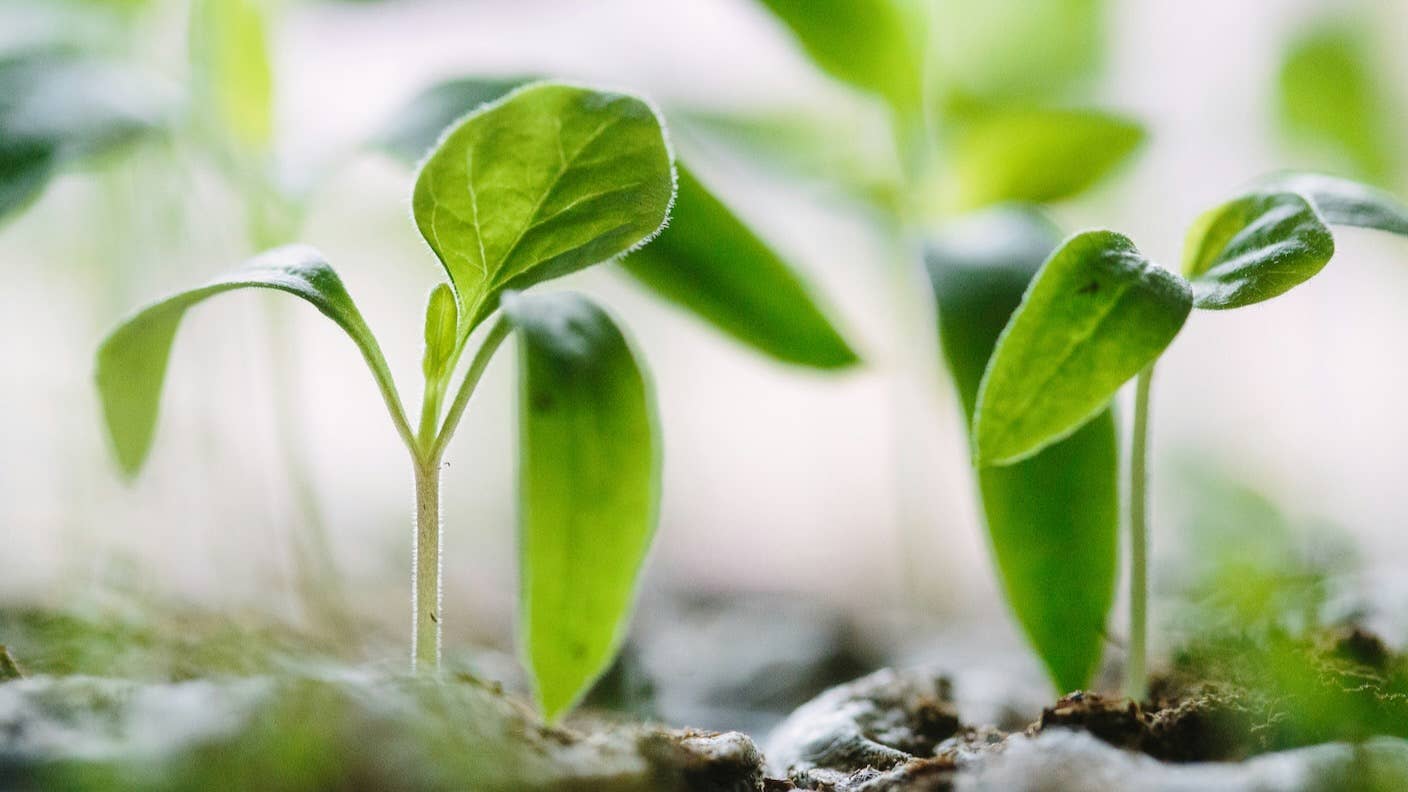This Radical New Farming Method Would Replace Photosynthesis With Solar Power

Share
Farming immediately sparks images of lush fields of leafy greens under a blue sky, corn blowing in the wind, or majestic terraced rice paddies carved into mountainsides. Agriculture changed societies and our food habits roughly 12,000 years ago when humans switched from nomadic hunter-gatherer lifestyles to more permanent settlements.
In recent centuries, innovative farming equipment and synthetic chemical fertilizers have boosted food production to feed an increasingly growing population of people. But as any backyard gardener knows, growing plant-based food—lettuce, tomatoes, herbs, grains, pumpkins—still mostly relies on the age-old strategy: Plant seeds in nutritious soil, keep them well hydrated with plenty of sunlight, and wait for them to grow.
This strategy has downsides. Agriculture uses nearly half of the world’s habitable land and accounts for up to a third of human-generated greenhouse gas emissions, wrote Feng Jiao at the Washington University in St. Louis and his team in a recent analysis.
The reason? While sunny regions naturally provide enough light to grow crops, areas with colder winters often need grow lights and greenhouses part of the year. This increases energy consumption, logistical headaches, and ultimately, food costs.
In their paper, Jiao and colleagues argue for a new method that could dramatically revamp farming practices to reduce land use and greenhouse gas emissions.
Dubbed “electro-agriculture,” the approach uses solar panels to trigger a chemical reaction that turns ambient CO2 into an energy source called acetate. Certain mushrooms, yeast, and algae already consume acetate as food. With a slight genetic tweak, we could also engineer other common foods such as grains, tomatoes, or lettuce to consume acetate.
It could be “a groundbreaking revolution in farming,” wrote the team.
According to one estimate, if the US were to fully adopt electro-agriculture, it would reduce agricultural land use by nearly 90 percent. A similar system could also allow more efficient crop growth during spaceflight, where efficiency in small spaces is key. With more research, it might even be possible to bypass traditional photosynthesis with acetate and grow plants in the dark.
“The whole point of this new process [is] to try to boost the efficiency of photosynthesis,” said Jiao in a press release. “Right now, we are at about four percent efficiency, which is already four times higher than for photosynthesis, and because everything is more efficient with this method, the CO2 footprint associated with the production of the food becomes much smaller.”
Man Versus Food
Agriculture is one of the most difficult domains in which to reduce carbon emissions. As the global population increases, its impact on the environment will likely grow.
“There is an urgent need for the global food system to be reimagined to sustain a habitable planet,” wrote the team.
Photosynthesis is at the heart of agriculture. In plants and some bacteria, green-tinted molecular machines called chloroplasts absorb sunlight and churn that light into energy. It’s no coincidence most farms are in sun-bathed areas liked central California.
Farmers and scientists have tried shrinking the agricultural footprint with vertical farming. True to form, vertical farms grow crops on stacked shelves rather than large horizontal fields. The method often relies on hydroponics, in which plants absorb nutrients from a water-based system instead of soil, similar to AeroGarden but at an industrial scale.
These systems run indoors, so plants can grow all year. But heavy reliance on artificial grow lights means high energy consumption limits their ability to scale.
Part of the problem is efficiency. Much of the “electricity supplied to the LED grow lights in conventional vertical farming is lost to heat,” explained the team.
Electro-agriculture, or “electro-ag,” skirts these challenges. The system captures ambient CO2 from the air and uses water and electricity to convert the gas into different molecules—including ethanol and acetate, which is “plant food” for some species.
Acetate is a vinegar-like chemical at the heart of many biological reactions. One recent study found that acetate made from CO2 could be used to cultivate yeast, mushrooms, and a type of green algae in total darkness without the need for natural photosynthesis. With some sunlight, the chemical boosted growth four-fold in nine different crop types compared to traditional farming techniques.
Be Part of the Future
Sign up to receive top stories about groundbreaking technologies and visionary thinkers from SingularityHub.


These initial results got scientists wondering: Can we use acetate alone to replace photosynthesis?
Not quite. Most adult crop plants naturally require photosynthesis to build up their weight and size. Plants grown with electro-ag would need to shift their metabolism to consume acetate—which most adult plants struggle to process—as a primary food source.
But plants can use the molecule for energy as they’re germinating from seeds. It’s a bit like people who drank milk as infants but later became lactose intolerant. The genetic programming is still there; it just needs to be reactivated.
Here’s where genetic engineering comes in.
By tweaking genes involved in acetate metabolism, it might be possible to reawaken the plants’ natural ability to digest the molecule. The strategy hasn’t been directly tested yet. But in bacteria, amping up a gene involved in acetate metabolism boosted their ability to eat it.
Engineering plants that eat acetate is a “critical step” toward building an electro-ag system.
The team envision a vertically stacked set-up to reduce land usage, kind of like a fridge with three sections. The first section—the roof—would be covered in solar panels to gather energy. The middle section would use this energy to break down CO2 and generate acetate to feed plants growing in the bottom section. Depending on the type of crop, this section could hold roughly three to seven “floors” of plants stacked on top of each other, like trays in a fridge.
Into the Wild
Electro-ag could benefit the environment, slashing total land usage for farming by roughly 88 percent in the US alone. This would free up over one billion acres of land that could be restored to natural ecosystems, such as dense forests. The technology could also help stabilize food prices. As weather becomes increasingly unpredictable due to climate change, developing nations are often hit hardest. A large-scale indoor system could help put a lid on volatility.
But how much all this would cost is still uncertain. The field is still in a very early stage. Currently, scientists are tweaking tomato and lettuce genes to increase their abilities to use acetate as food. High-calorie staple crops, such as potato, corn, rice, and wheat, are next on the list. Plants aside, a similar technology—in theory—could also be used for cultivating dairy and plant-based meat, although the idea hasn’t been tested yet.
“This is just the first step for this research, and I think there's a hope that its efficiency and cost will be significantly improved in the near future,” said Jiao.
Image Credit: Francesco Gallarotti on Unsplash
Dr. Shelly Xuelai Fan is a neuroscientist-turned-science-writer. She's fascinated with research about the brain, AI, longevity, biotech, and especially their intersection. As a digital nomad, she enjoys exploring new cultures, local foods, and the great outdoors.
Related Articles

AI Can Now Design Proteins and DNA. Scientists Warn We Need Biosecurity Rules Before It’s Too Late.

Kids With Spinal Muscular Atrophy Show Dramatic Improvement With FDA-Approved Gene Therapy

How Will the Universe End? The Dark Eternity That Awaits Us Trillions of Years From Now
What we’re reading